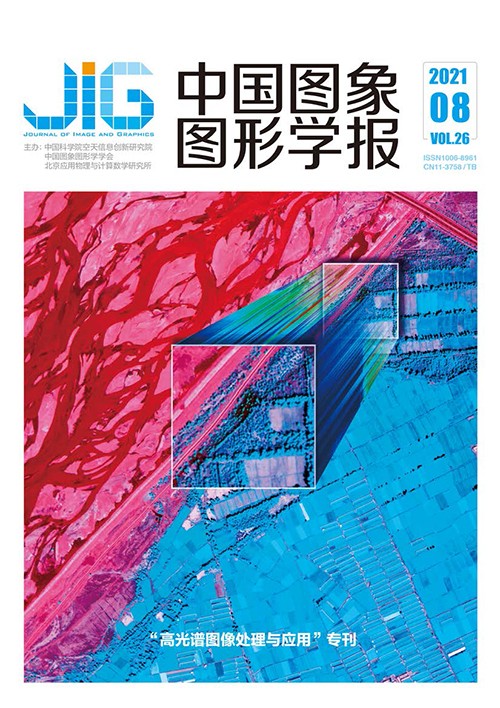
基于频率加权张量核范数的高光谱图像复原
摘 要
目的 高光谱图像复原是高光谱领域中一个重要的预处理步骤,能够有效去除成像条件所带来的不利影响,提升后续处理任务的精度。张量核范数被广泛应用于高光谱复原问题中,得到了较好的结果。然而,在张量核范数的定义中,它对张量所有奇异值使用相同的阈值进行收缩,未充分考虑高光谱的物理意义,得到了次优的结果。为了提升高光谱图像复原的精度,本文提出了基于频率加权张量核范数的高光谱复原算法。方法 在张量的频率域内,对清晰的高光谱图像添加噪声,图像信息在低频部分变化较小,而在高频部分变化巨大。基于这样的物理意义,定义了一种频率加权张量核范数来逼近张量秩函数,提出了频率域权重的自适应确定方法,让其能减少对低频部分的收缩,同时加大高频部分惩罚。然后将其应用于高光谱图像复原和去噪问题中,并基于交替方向乘子法设计了相应最小化问题的快速求解算法。结果 在4个高光谱数据集上与相关方法进行对比仿真实验,高采样率条件下在Washington DC Mall数据集上,相比性能第2的模型,本文模型复原结果的PSNR (peak signal-to-noise ratio)提升了1.76 dB;在Stuff数据集上,PSNR值提升了2.91 dB。高噪声条件下,在Pavia数据集上相比性能第2的模型,本文模型去噪结果的PSNR提升了8.61 dB;在Indian数据集上,PSNR值提升了10.77 dB。结论 本文模型可以更好地探索高光谱图像的低秩特性,使复原的图像在保持主体信息的同时,复原出更多图像纹理细节。
关键词
Hyperspectral image restoration based on frequency-weighted tensor nuclear norm
Liu Sheng1, Zeng Haijin1, Kong Wenfeng1, Zhang Pengdan2(1.College of Science, Northwest A&F University, Yangling 712100, China;2.College of Information Engineering, Northwest A&F University, Yangling 712100, China) Abstract
Objective Hyperspectral images (HSIs) use imaging spectrometers to collect hundreds of spectral band images from ultraviolet to infrared wavelengths on the same area of the earth's surface. Tens to hundreds of continuous grayscale images are available, and each pixel can extract a spectral curve. Hyperspectral imaging technology closely combines the traditional 2D image remote sensing technology and spectroscopy technology. While acquiring the spatial information of the ground object, it arranges the radiation energy of the measured object according to the wavelength and obtains hundreds of continuous data in a spectral range. It is widely used in various fields, such as environmental monitoring and terrain classification. However, real HSI is often subject to different types of pollution, namely, noise, undersampling, or missing data, because of actual imaging conditions, weather conditions, or data transmission procedures. These types of pollution severely reduce the quality of HSI and limit the accuracy of subsequent processing tasks, such as unmixing and target detection. Restoration from a noisy, undersampling, or incomplete HSI is an ill-posed inverse problem. A common method is to treat each band as a grayscale image or column HSI into 2D matrix and use the method of matrix restoration to process it. Rank minimization is a common strategy to solve such problems. However, the rank function is discrete and non-convex, and the solution of the rank function minimization problem is an nondeterministic polynominal(NP)-hard problem. The convex envelope-nuclear norm of the rank function is usually used to approximate the rank function for solving this problem, and the rank minimization problem is transformed into the nuclear norm minimization problem. Although nuclear norm can achieve good restoration results, it imposes the same shrinkage on all singular values of the matrix due to the limitation of convexity. This imposition results in a finite degree approximation of the rank function. At the same time, HSI is an imaging of the same scene under different spectra, and its data in each band are highly correlated. This correlation is often ignored. The exploration of the low-rank characteristics of HSI by an approach of the column matrix is insufficient. Method One of the methods to define the rank of the tensor is tensor singular value decomposition, which can also be solved by the tensor nuclear norm. However, all singular values are treated equally in the definition of the tensor nuclear norm, and the frequency information of the tensor is ignored. In the frequency domain of the tensor, noises are added to the clear hyperspectral image. The image information changes slowly in the low-frequency forward slicing matrix, but it changes markedly in the high-frequency forward slicing matrix. In this study, we propose a frequency-weighted tensor nuclear norm based on the physical properties of tensors in the frequency domain. The original tensor is protected under the condition of removing outliers by appropriately reducing the penalty for the low-frequency forward slicing matrix. The main information is to increase the penalty for the high-frequency forward slicing matrix, which can fully remove the outliers in the tensor. Ultimately, the degree of approximation of the tensor nuclear norm to the tensor rank is improved to enhance the accuracy of restoration. At the same time, we explore the changes in the frequency components of the hyperspectral image when the sparse noise is disturbed through numerical simulation experiments. The sparse noise slightly affects the nuclear norm of the low-frequency band slice matrix, but it influences the high-frequency band slice matrix nuclear norm. The nuclear norm of the low-frequency band slice matrix changes slowly when the noise intensity increases, while that of the high-frequency band slice matrix changes markedly. On this basis, we give the weight adaptive calculation method of each frequency forward slice matrix, increase the adaptive data based on the frequency-weighted tensor nuclear norm, and reduce the human intervention in the parameter adjustment process to ensure robustness of the model. Result We compare simulation experiments with related methods on four hyperspectral datasets. On the simulated dataset, the sampling rates are 10%, 20%, and 30%. Compared with the indices of the second best performing model, the peak signal-to-noise ratio (PSNR) index and the structure similarity (SSIM) index on the Washington DC Mall dataset can be increased by 0.98 dB, 1.64 dB, and 1.76 dB, and 0.005 8, 0.019 3, and 0.010 2. Compared with the indices of the second best performing model, the PSNR and SSIM values of the restoration result of the proposed model on the Stuff dataset can be increased by 1.84 dB, 2.65 dB, 2.91 dB, and 0.085 2, 0.042 5, and 0.023 1. The sparse noise intensity values are 0.5 and 0.4. Compared with the indices of the second best performing model, the PSNR and SSIM values of the denoising results of the proposed model on the Pavia dataset can be increased by 8.61 dB and 6.67 dB, and 0.441 and 0.087 41. Compared with the indices of the second best performing model, the PSNR and SSIM values of the denoising results of the proposed model on the Indian dataset can be increased by 10.77 dB and 6.34 dB and 0.403 and 0.033 1. Conclusion The proposed model considers the original HSI information carried by different frequency slices and the influence of missing or sparse noise on the nuclear norm of each frequency slice. It can better explore the low-rank characteristics of hyperspectral images. Thus, the restored HSI can be maintained. More texture details are restored simultaneously with the main information.
Keywords
|



 中国图象图形学报 │ 京ICP备05080539号-4 │ 本系统由
中国图象图形学报 │ 京ICP备05080539号-4 │ 本系统由